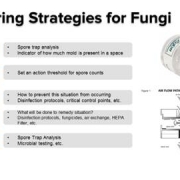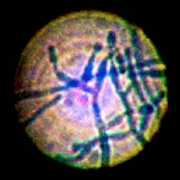T-2 Mycotoxins and Biological Warfare – Same Destructive Agent as Indoor Mold
MYCOTOXINS (T2)
T-2 mycotoxins and Yellow Rain – the same destructive neurological and immunological agents that are found in indoor molds.
Summary
Currently, the United States Army is conducting 90% of their biological warfare research in T-2 mycotoxins, according to Dr. William Deagle, in a recent telephone interview. These are the same T-2 mycotoxins that are common properties in many household molds.
Overview
Mycotoxins are naturally occurring substances produced by fungi as a secondary metabolite that typically affords the organism survival benefit (eg, penicillin). Many of these toxins are pathogenic to animals and humans. An estimated more than 300 mycotoxins are produced by some 350 species of fungi. The T-2 mycotoxin, which is classified as a trichothecene mycotoxin, is elaborated from the fusariam, aspergillus, and stachybotrys species of fungus.
The trichothecene mycotoxins are low molecular weight (250-500 daltons) nonvolatile compounds produced by filamentous fungi (molds) of the genera Fusarium, Myrotecium, Trichoderma, Stachybotrys and others. The structures of approximately 150 trichothecene derivatives have been described in the literature. These substances are relatively insoluble in water but are highly soluble in ethanol, methanol and propylene glycol. The trichothecenes are extremely stable to heat and ultraviolet light inactivation. Heating to 1500o F for 30 minutes is required for inactivation, while brief exposure to NaOCl destroys toxic activity. The potential for use as a BW toxin was demonstrated to the Russian military shortly after World War II when flour contaminated with species of Fusarium was unknowingly baked into bread that was ingested by civilians. Some developed a protracted lethal illness called alimentary toxic aleukia (ATA) characterized by initial symptoms of abdominal pain, diarrhea, vomiting, prostration, and within days fever, chills, myalgias and bone marrow depression with granulocytopenia and secondary sepsis. Survival beyond this point allowed the development of painful pharyngeal/laryngeal ulceration and diffuse bleeding into the skin (petechiae and ecchymoses), melena, bloody diarrhea, hematuria, hematemesis, epistaxis and abnormal bleeding. Pancytopenia, and gastrointestinal ulceration and erosion were secondary to the ability of these toxins to profoundly arrest bone marrow and mucosal protein synthesis and cell cycle progression through DNA replication.
History and Significance
According to the current declassified literature, the T-2 mycotoxin is the only mycotoxin known to have been used as a biological weapon. The trichothecene mycotoxins are low molecular weight compounds (250-500 d, averaging 466 d) that are nonvolatile, relatively insoluble in water, and highly soluble in ethanol, methanol, and propylene glycol. The toxin is highly heat stable and resistant to UV light destabilization (2 important factors when considering an agent as a biological warfare agent).
There is much confusion between inhalation and ingestion of mycotoxins, both being having equally, although slightly different, devastating health effects.
Ingestion: Information regarding the effects of T-2 mycotoxin on humans has been collected from many incidents of accidental ingestion of moldy wheat or corn. One such incident involved the Orenburg district of Russia during World War II. Most men in the village were fighting in the war, leaving the wheat crop unharvested, which resulted in the crop remaining in the fields over the winter. It was harvested in the spring and consumed, causing the clinical syndrome alimentary toxic aleukia (ATA), with varied reports of 10-60% mortality. Some reports demonstrate that T-2 mycotoxin was the operative agent in the “plague” of Athens in 430 BC. Additional information about the clinical effects of T-2 mycotoxin has been demonstrated in the laboratory using human cell cultures and animal models.
Inhalation: Declassified reports prove that T-2 mycotoxin has been used as a simple but effective biological warfare agent on several occasions. The most common strategy was when heavily used in aerosol form (“yellow rain”) to produce lethal and non-lethal casualties in in the country of Laos during the Vietnam War. The report of “yellow rain” in remote sections of jungle in Laos (1975-81), which resulted in more than 6,378 deaths, has been viewed as use of T-2 mycotoxin as a biological weapon. Evidence regarding the use of the toxin in Laos has been declassified and well-documented, but many health historians still try to debate this fact to evade the topic of such inhumane abuse of bio-toxins. Other reported uses of T-2 mycotoxin as a biological weapon concern Kampuchea (1979-81) with 1,034 deaths and Afghanistan (1979-81) with 3,042 deaths. The victims were usually unarmed civilians or guerrilla forces. Eyewitness reports sated that the deaths appeared almost instantaneous in some cases, where many appeared to have suffered with severe neurological failure for up to fourteen months. These groups were not protected with masks or chemical protective clothing and had little or no capability of destroying the attacking enemy aircraft. These attacks occurred in remote jungle areas which made confirmation of attacks and recovery of agent extremely difficult.
More recently, it has been prominent that T-2 mycotoxin was disseminated near a US military camp in Saudi Arabia during the Desert Storm campaign. An Iraqi missile detonated over or near the camp. Some of the troops in the area reported immediate symptoms determined to be mycotoxicosis. The government has denied this event, although many witnesses have verified the evidence consistent with the use of this agent. It has also been well-documented that exposure to T-2 mycotoxins and depleted uranium is the exact cause of Gulf War syndrome.
Qualities important to producing an effective chemical or biological weapon are its ease of manufacture, ease of weaponization, durability of the organism or toxin in storage form, ease of dispersal, and chemical stability when exposed to heat although safe levels of ozone and UV radiation have been the only substances that can compromise its effectiveness which humans can also be exposed to. Other factors include ease of concealment and ability to directly obtain the agent or organism that produces the agent. In the early half of the century, biotoxins were investigated as military weapons. These types of weapons fell into disfavor primarily because of problems with weaponization of the biotoxin material. The US closed its biotoxin program in the 1960s. Interest was rekindled in the 1970s with improvements in gene technology and biotechnology. Although the US has no current offensive biological weapons capability, these agents are less expensive than nuclear and chemical weapons and therefore appeal to smaller countries or terrorist organizations. Approximately 90% of all biological warfare studies conducted by the government are in T-2 mycotoxins as a neurological impairment vehicle.
Because of limitations in the manufacture of sufficient quantities, biotoxins are not optimal agents for mass dispersal. This agent is better suited as a small-group assassination tool, since a small amount can be dispersed effectively in enclosed areas. As an assassination tool, T-2 mycotoxins can be used as a food or water-borne poison. The T-2 mycotoxin is the only biologically active toxin effective through dermal exposure and respiratory and gastrointestinal (GI) portals. The route of entry and dose dictate the clinical course. Tissues involved in high cellular turnover (eg, GI and respiratory epithelium, bone marrow cellular elements) are most susceptible to these toxins, but expsoure can be carcinogenic and demyelinating with some species.
Clinical Features
T-2 and other mycotoxins may enter the body through the skin and digestive or respiratory epithelium. They are fast acting potent inhibitors of protein and nucleic acid synthesis. Their main effects are on rapidly proliferating tissues such as the bone marrow, skin, mucosal epithelia, and germ cells. In a successful BW attack with trichothecene toxin (T-2), the toxin(s) can adhere to and penetrate the skin, be inhaled, or can be ingested. Clothing would be contaminated and serve as a reservoir for further toxin exposure.
In laboratory rats, the LD50 (dose to cause 50% lethality) is 4 mg/kg when ingested. The LD50 for dermal exposure is reportedly 2-12 mg/kg. In mice, the LD50 for aerosol exposure is 1.2 mg/kg. The trichothecene class of toxins is considered among the most potent naturally occurring toxic substances.
Early symptoms beginning within minutes of exposure include burning skin pain, redness, tenderness, blistering, and progression to skin necrosis with leathery blackening and sloughing of large areas of skin in lethal cases. Nasal contact is manifested by nasal itching and pain, sneezing, epistaxis and rhinorrhea; pulmonary/tracheobronchial toxicity by dyspnea, wheezing, and cough; and mouth and throat exposure by pain and blood tinged saliva and sputum. Acid relfux, nausea, vomiting and watery or bloody diarrhea with abdominal crampy pain occurs with gastrointestinal toxicity. Eye pain, tearing, redness, foreign body sensation and blurred vision may follow entry of toxin into the eyes. Skin symptoms occur in minutes to hours and eye symptoms in minutes. Systemic toxicity is manifested by weakness, prostration, dizziness, ataxia, and loss of coordination. Tachycardia, hypothermia, and hypotension follow in fatal cases. Death may occur in minutes, hours or days. The most common symptoms are vomiting, diarrhea, skin involvement with burning pain, redness and pruritus, rash or blisters, bleeding, and dyspnea.
Diagnosis
Rapid onset of symptoms in minutes to hours supports a diagnosis of a chemical or toxin attack. Mustard agents must be considered but they have an odor, are visible, and can be rapidly detected by a field available chemical test. Symptoms from mustard toxicity are also delayed for several hours after which mustard can cause skin, eye and respiratory symptoms. Staphylococcal enterotoxin B delivered by an aerosol attack can cause fever, cough, dyspnea and wheezing but does not involve the skin and eyes. Nausea, vomiting, and diarrhea may follow swallowing of inhaled toxin. Ricin inhalation can cause severe respiratory distress, cough, nausea and arthralgias. Swallowed agent can cause vomiting, diarrhea, and gastrointestinal bleeding, but it spares the skin, nose and eyes. Specific diagnosis of T-2 mycotoxins in the form of a rapid diagnostic test is not presently available in the field. Removal of blood, tissue from fatal cases, and environmental samples for testing using a gas liquid chromatography-mass spectrometry technique will confirm the toxic exposure. This system can detect as little as 0.1-1.0 ppb of T-2. This degree of sensitivity is capable of measuring T-2 levels in the plasma of toxin victims.
Pathophysiology
The pathophysiology of T-2 mycotoxin is multifactorial. It causes DNA breaks, chromosomal abnormalities, and inhibition of protein synthesis. Inhibition of protein synthesis seems to be the primary cause of symptoms in intoxicated patients. Conflicting reports of the mechanism involving the inhibition of protein synthesis exist. One theory relates it to the toxin’s affinity for the 60S ribosomal subunit, therefore inhibiting protein synthesis at the initial step. Another theory involves the inactivation of peptidyl transferase, which inhibits the terminal step of protein synthesis. The mechanism of action on DNA is not clear but is believed to be related indirectly to the cessation of protein synthesis. Chaetomium and stachybotrys produces mycotoxins that have been determined to destroy the myelin sheath, leading to a multiplicity of autoimmune disease including Diabetes II, lupus, and multiple sclerosis.
Signs and symptoms
Exposure causes skin pain, pruritus, easy bruising, redness, vesicles, necrosis and sloughing of epidermis. Effects on the airway include nose and throat pain, nasal discharge, itching and sneezing, cough, dyspnea, wheezing, chest pain, burning, and hemoptysis. Toxin also produces effects after ingestion or eye contact. Severe poisoning results in prostration, infertility, weakness, ataxia, balance/coordination problems, collapse, shock, memory and other cognitive complications including seizures, and death. There are also several U.S. Army studies that quantify permanent immunological and psychological factors that have left permanent disabilities along with IQ abnormalities after exposure.
Diagnosis
Should be suspected if an aerosol attack occurs in the form of “yellow rain” with droplets of yellow fluid contaminating clothes and the environment. Confirmation requires testing of blood, tissue and environmental samples. Serum mycotoxin antibodies tests, DNA, and other blood work can be conducted to determine exposure. Many of these mycotoxins are undetectable in an autopsy.
Treatment
There is no specific antidote other than detoxifying with natural substances and replenishing lipids, nutrients, enzymes, amino acids, and probiotics, and restricted diet. Superactivated charcoal should be given orally if the toxin is swallowed. On extremely rare occasions, radical treatments such as prescriptions like antifungal treatment may be necessary if natural treatment is not effective.
Isolation and Decontamination: Standard Precautions for healthcare workers. Outer clothing should be removed and exposed skin should be decontaminated with soap and water. Eye exposure should be treated with copious saline irrigation. Once decontamination is complete, isolation is not required. Environmental decontamination requires the use of a hypochlorite solution under alkaline conditions such as 1% sodium hypochlorite and 0.1M NAOH with 1 hour contact time. Controlled UV light and ozone can be the only method to decontaminate porous substances with human exposure.
Medical Management
Use of a chemical protective mask and clothing prior to and during a mycotoxin aerosol attack will prevent illness. If a soldier is unprotected during an attack the outer uniform should be removed within 4 hours and decontaminated by exposure to 5% hypochlorite for 6-10 hours. The skin should be thoroughly washed with soap and uncontaminated water if available. The M291 skin decontamination kit should also be used to remove skin adherent T-2. Superactivated charcoal can absorb swallowed T-2 and should be administered to victims of an unprotected aerosol attack. The eyes should be irrigated with normal saline or water to remove toxin.
Prophylaxis
Physical protection of the skin and airway are the only proven effective methods of protection during an attack. Immunological (vaccines) and chemoprotective pretreatments are being studied in animal models, but are not available for field use by the warfighter. The only defense is to wear a protective mask and clothing during an attack. No specific immunotherapy or chemotherapy is available for use in the field.

 Cannabisindustryjournal.com
Cannabisindustryjournal.com 





